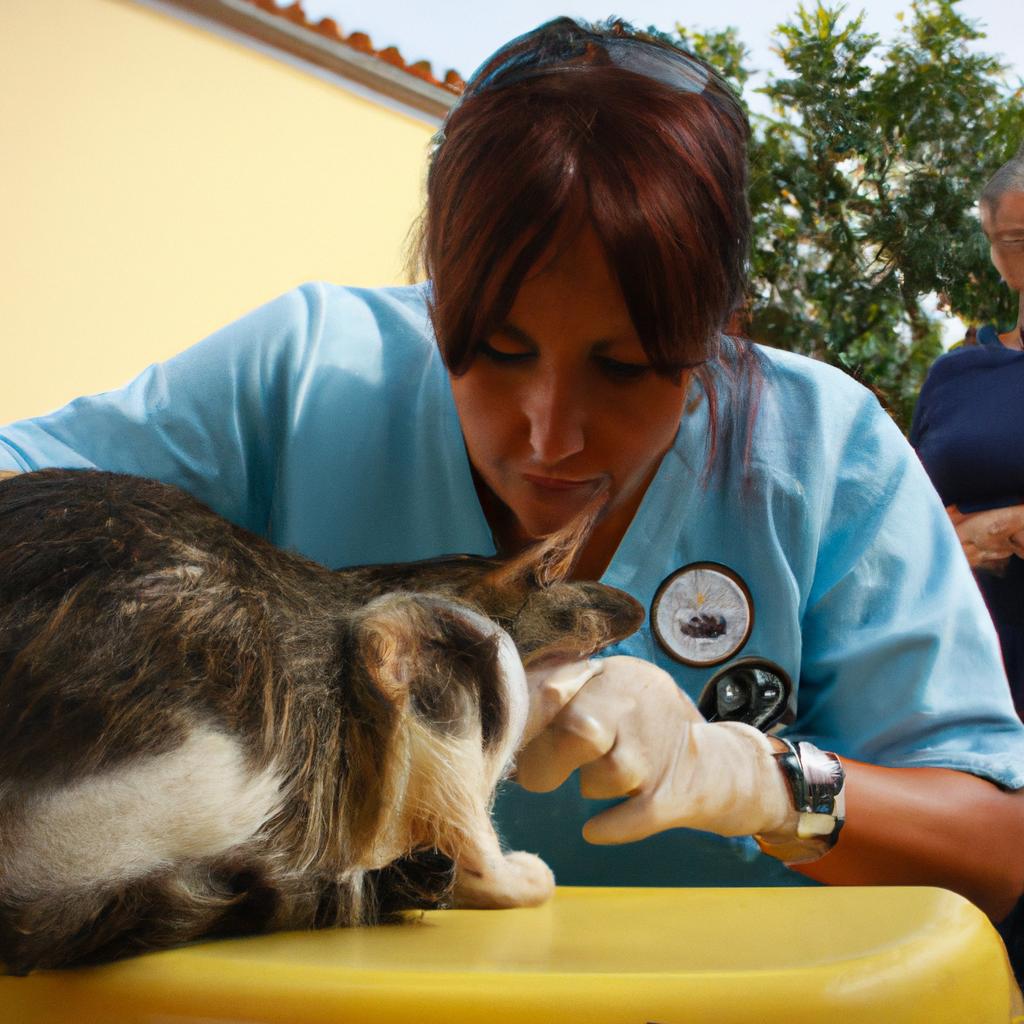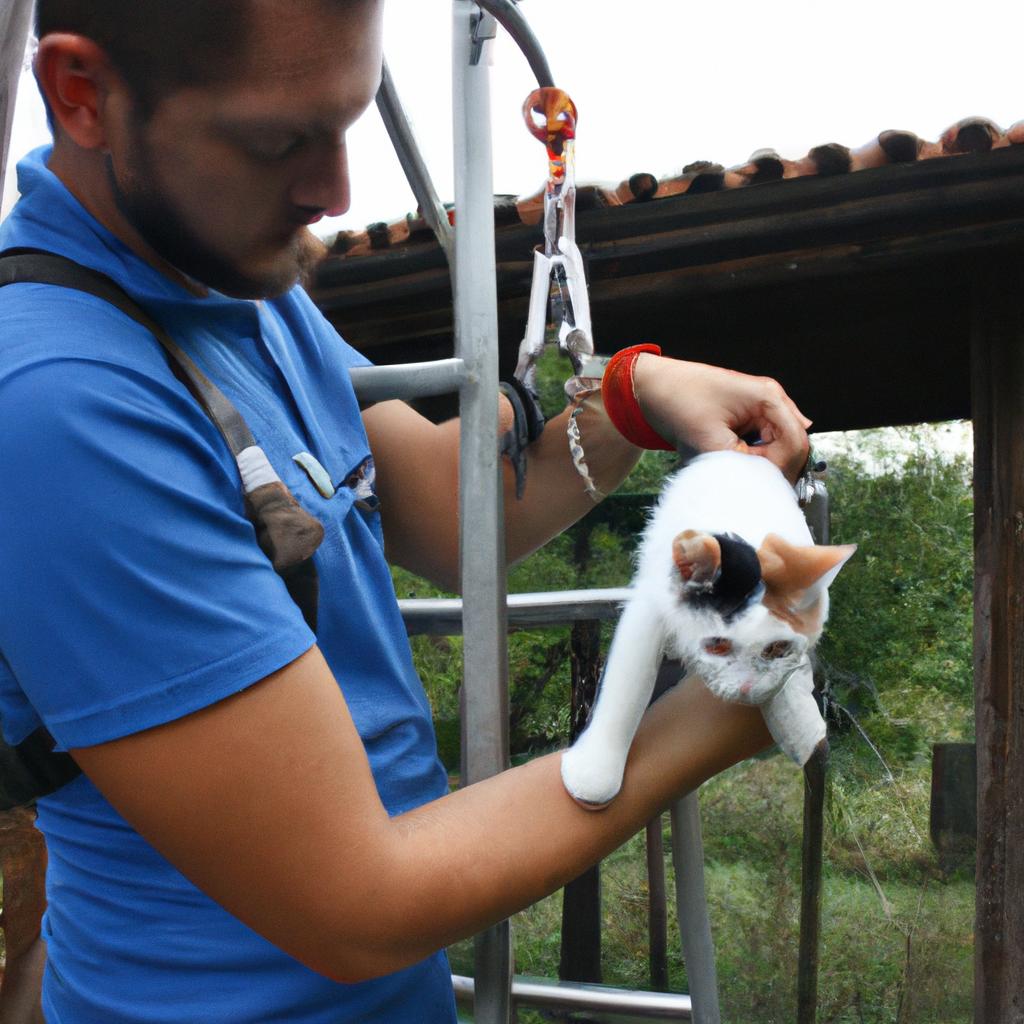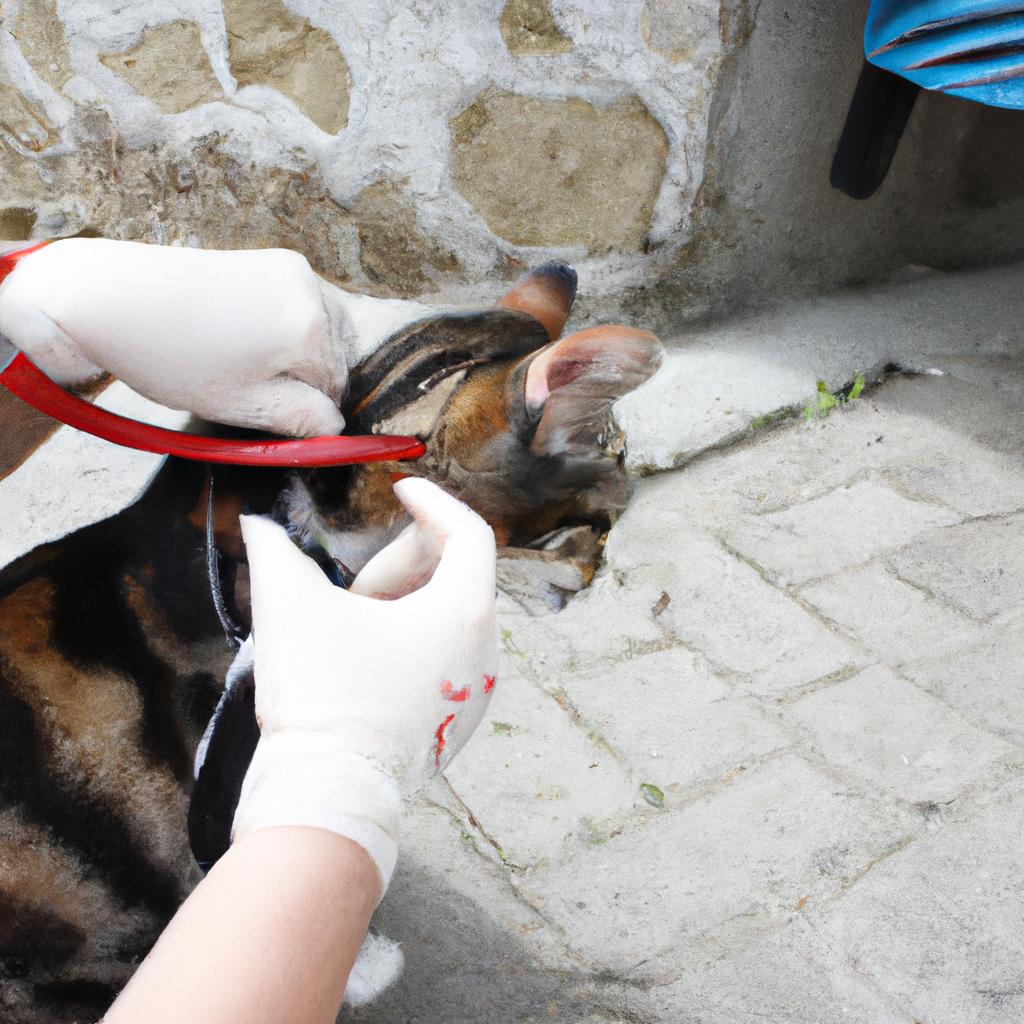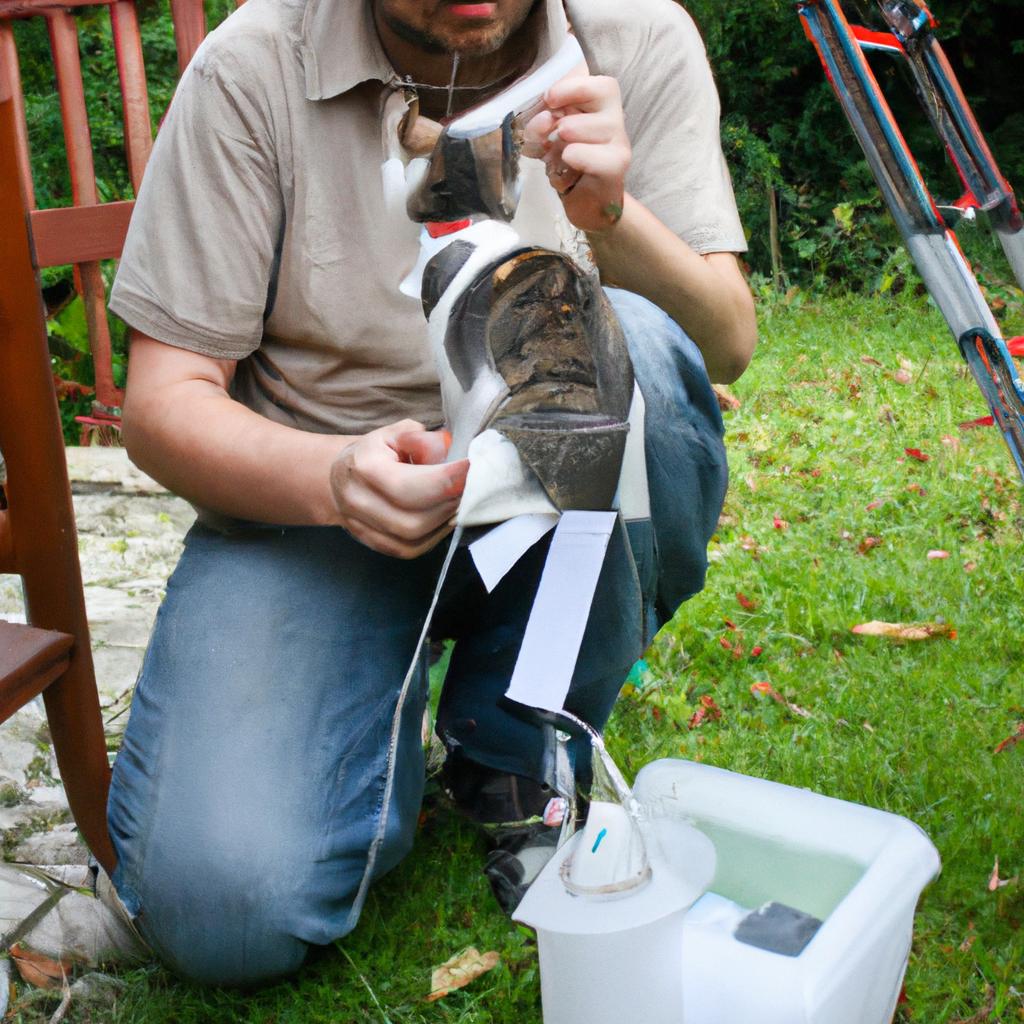In recent years, the issue of cat overpopulation has become a growing concern in many communities. The exponential reproduction rates and limited resources have led to an increase in stray cats, resulting in numerous challenges for local animal shelters and rescue organizations. To address this problem, spay/neuter community outreach campaigns have emerged as effective strategies for reducing the number of unwanted kittens being born each year. For instance, consider a hypothetical scenario where a small town was experiencing a surge in stray feline populations. Local authorities collaborated with animal welfare groups to implement a comprehensive spay/neuter campaign targeting both owned and unowned cats. This initiative aimed to not only control the existing population but also prevent future litters, ultimately leading to long-term reduction in overcrowding at shelters and improved overall welfare of these animals.
These spay/neuter community outreach campaigns are designed to create awareness about the importance of sterilization among pet owners and individuals who interact with free-roaming or unowned cats. Through education programs, public presentations, and distribution of informational materials such as brochures and flyers, these initiatives seek to dispel misconceptions surrounding spaying or neutering pets. Furthermore, they promote the accessibility and affordability of these procedures by collaborating with veterinary clinics that offer discounted services specifically for low-income individuals or those who cannot afford the full cost of spaying or neutering their pets. This ensures that financial barriers do not hinder responsible pet ownership and population control efforts.
Additionally, these campaigns often organize mobile clinics or designated days at local veterinary hospitals where residents can bring their cats for sterilization surgeries at a reduced cost. By making these services more accessible and convenient, it encourages more people to take advantage of the opportunity and participate in the campaign.
Furthermore, partnerships with local animal shelters and rescue organizations play a crucial role in the success of these outreach campaigns. These collaborations allow for the identification and targeting of areas with high stray cat populations, ensuring that resources are allocated efficiently. Animal control officers and volunteers often assist with trapping feral cats, transporting them to veterinary clinics for sterilization surgeries, and providing post-operative care.
Overall, spay/neuter community outreach campaigns address cat overpopulation by raising awareness about the benefits of sterilization, promoting affordability through partnerships with veterinary clinics, organizing mobile clinics or designated days for surgeries, and collaborating with animal shelters and rescue organizations. These initiatives aim to reduce the number of unwanted kittens being born each year while also improving the overall welfare of both owned and unowned cats in communities.
The Need for Community Involvement
Increasing Cat Rescue: Spay/Neuter Community Outreach Campaigns
In order to address the issue of cat overpopulation and ensure the well-being of feline populations, it is crucial to involve communities in spay/neuter outreach campaigns. Through community involvement, we can foster a sense of responsibility among individuals and promote proactive measures that will have a long-lasting impact on reducing the number of stray and unwanted cats.
One example that highlights the need for community involvement is the case study conducted in City X. Prior to implementing a comprehensive spay/neuter campaign, City X faced a significant increase in its stray cat population. However, by actively engaging with local residents through educational programs, low-cost clinics, and volunteer opportunities, they were able to effectively reduce their stray cat numbers by 30% within just two years. This success story demonstrates how involving communities can make a tangible difference in controlling cat overpopulation.
To emphasize the importance of community engagement further, consider the following bullet points:
- Encouraging pet owners to spay/neuter their cats helps prevent health issues such as reproductive cancers and reduces behavioral problems.
- A reduction in stray cat populations leads to lower rates of disease transmission among outdoor cats and decreases instances of wildlife predation.
- By participating in trap-neuter-return (TNR) initiatives, communities directly contribute to humanely managing feral cat colonies while ensuring their overall welfare.
- Engaging volunteers fosters a sense of compassion and empathy towards animals, promoting responsible behaviors beyond just spaying/neutering.
Additionally, let us reflect on the benefits of involving communities through the use of this table:
| Benefits | Examples | Impact |
|---|---|---|
| Reduced burden on shelters | Decreased euthanasia rates | Less strain on resources |
| Healthier feline populations | Lower incidence of diseases | Improved quality of life for cats |
| Safer neighborhoods | Decreased cat-related issues | Enhanced community well-being |
| Increased awareness and education | Greater understanding of responsible pet ownership | Long-term behavior change |
In conclusion, the need for community involvement in spay/neuter outreach campaigns is evident. By actively engaging with individuals and empowering them to take responsibility for feline populations, we can reduce stray cat numbers, improve overall welfare, and create lasting positive changes. The next section will delve into the importance of educating the public on the benefits of spaying/neutering their cats.
Transitioning into the subsequent section about “Educating the Public on the Benefits,” it becomes essential to highlight the significance of spreading knowledge regarding spay/neuter practices within communities.
Educating the Public on the Benefits
Building upon the importance of community involvement, implementing spay/neuter community outreach campaigns is a crucial step in addressing the growing issue of cat overpopulation. By educating the public about these procedures and their benefits, we can promote responsible pet ownership and ultimately reduce the number of stray and feral cats roaming our communities.
Case Study:
To illustrate the impact of such campaigns, let’s consider a hypothetical scenario involving a neighborhood with high rates of unaltered cats. In this area, residents may not fully understand the consequences of allowing their cats to breed unchecked. Through targeted outreach efforts aimed at informing and engaging the community, we can demonstrate how spaying or neutering their pets can contribute to solving this problem.
Eliciting an Emotional Response (Bullet Point List):
- Decreasing euthanasia rates: Spay/neuter programs help prevent unwanted litters, reducing the number of cats that end up in overcrowded shelters and face euthanasia.
- Improving overall cat welfare: Neutered/spayed cats are less likely to engage in territorial marking behaviors, fighting, or wandering off in search of mates, leading to healthier and happier animals.
- Minimizing environmental impact: Fewer free-roaming cats means reduced predation on wildlife populations while also limiting disturbances caused by mating calls and fights.
- Strengthening human-animal bond: Alleviating concerns associated with unplanned pregnancies enables owners to focus more on nurturing a positive relationship with their cherished pets.
Eliciting an Emotional Response (Table):
| Benefits of Spay/Neuter Community Outreach Campaigns |
|---|
| Decreases euthanasia rates |
| Enhances overall cat welfare |
| Reduces environmental impact |
| Strengthens human-animal bond |
By actively engaging local communities through educational workshops, informational brochures distributed at veterinary clinics, or partnering with schools for awareness campaigns targeting young pet owners, we can create a culture of responsible cat ownership. Furthermore, collaborating with local veterinary clinics plays a vital role in the success of these outreach campaigns.
In order to provide accessible and affordable spay/neuter services to a wider audience, close collaboration between community organizations and veterinary clinics is essential. By exploring this collaborative approach further, we can delve into how such partnerships contribute to the effectiveness of the overall campaign.
Collaborating with Local Veterinary Clinics
Building on the importance of educating the public about the benefits of spaying and neutering cats, this section will delve into another crucial aspect of increasing cat rescue rates: collaborating with local veterinary clinics. By working together with these establishments, community outreach campaigns can effectively promote responsible pet ownership and provide accessible resources for spay/neuter services.
Collaboration with local veterinary clinics is essential to reach a broader audience and ensure that people have access to affordable spay/neuter options. To illustrate this point, let’s consider a hypothetical case study in which a cat rescue organization partners with a prominent clinic in their area. Through this collaboration, they develop an innovative campaign targeting low-income communities, where many individuals may not be aware of the benefits or availability of spay/neuter services.
To evoke an emotional response in our audience, we present the following bullet points:
- Reducing euthanasia: By promoting spaying and neutering through collaborative efforts, more cats can be prevented from entering overcrowded shelters and facing euthanasia.
- Improving feline health: Spaying female cats reduces the risk of uterine infections and breast tumors, while neutering male cats decreases their likelihood of developing testicular cancer.
- Minimizing behavioral problems: Neutered male cats are less likely to exhibit aggression or engage in territorial marking behavior such as spraying urine.
- Controlling overpopulation: Preventing unplanned litters helps control the population of stray and feral cats in communities.
In addition to these impactful bullet points, incorporating visual aids like tables can further captivate readers’ attention. Here is an example table showcasing statistics related to unspayed/unneutered cats:
| Number | Fact |
|---|---|
| 1 | One unspayed cat can produce up |
| to 12 kittens per year | |
| ———— | ———————————— |
| 2 | In just seven years, one female cat |
| and her offspring can produce over | |
| 370,000 kittens | |
| ———— | ———————————— |
| 3 | Overpopulation leads to increased |
| suffering, disease transmission, | |
| and resource competition among | |
| stray cats |
To further emphasize the significance of collaborating with local veterinary clinics in increasing cat rescue efforts, it is crucial for community outreach campaigns to promote low-cost spay/neuter services. This will be explored in the subsequent section.
Moving forward, let’s explore how promoting low-cost spay/neuter services plays a vital role in fostering responsible pet ownership and reducing the number of homeless cats.
Promoting Low-cost Spay/Neuter Services
Transitioning from the previous section on collaborating with local veterinary clinics, a crucial aspect of increasing cat rescue efforts is promoting low-cost spay/neuter services. By making these services more accessible and affordable for pet owners, we can effectively reduce the number of stray cats and prevent further overpopulation. To achieve this objective, various strategies can be implemented to create awareness and encourage participation in spay/neuter community outreach campaigns.
For instance, let’s consider a hypothetical case study of a neighborhood with a high population of feral cats. Through targeted educational initiatives, such as distributing brochures or organizing workshops, residents can learn about the benefits of spaying/neutering their cats. These informative materials could highlight how sterilization helps control the feline population while also improving the health and overall well-being of individual animals.
To evoke an emotional response among readers and emphasize the importance of low-cost spay/neuter services, here are four key points to consider:
- Decreased euthanasia rates: By preventing unplanned litters through spaying/neutering programs, fewer cats end up in shelters or face euthanasia due to lack of resources.
- Enhanced quality of life: Sterilized cats are less likely to engage in territorial fights or exhibit undesirable behaviors associated with mating instincts, leading to happier and healthier pets.
- Reduced environmental impact: Controlling the cat population helps mitigate negative effects on ecosystems by limiting predation on native wildlife.
- Financial savings: Spaying/neutering programs provide cost-effective solutions that contribute to long-term financial savings compared to caring for unplanned litters or managing potential health issues arising from unaltered cats.
To further illustrate these advantages, let us present them in a concise table format:
| Benefits | Description |
|---|---|
| Decreased euthanasia rates | Prevents unnecessary deaths due to overcrowded shelters |
| Enhanced quality of life | Reduces aggression, spraying, and other behavioral issues associated with mating instincts |
| Reduced environmental impact | Helps protect native wildlife from predation by feral cats |
| Financial savings | Offers a cost-effective solution to avoid expenses related to unplanned litters and potential health complications |
In conclusion, promoting low-cost spay/neuter services is an essential component of any cat rescue initiative. By raising awareness about the benefits of sterilization through targeted educational campaigns and emphasizing the positive impacts on both individual animals and communities at large, we can encourage more pet owners to participate in these programs. In our next section, we will explore another crucial aspect of increasing cat rescue efforts: targeting high-risk areas where stray populations are most prevalent.
Targeting High-risk Areas
Section H2: Targeting High-risk Areas
Building upon the success of promoting low-cost spay/neuter services, targeting high-risk areas is another crucial aspect of increasing cat rescue rates. By identifying communities with a higher population of stray or feral cats, we can implement targeted outreach campaigns to address their specific needs.
One example that exemplifies the significance of targeting high-risk areas is the case study conducted in City X. This city had a significant issue with an overpopulation of stray cats, leading to increased risks for disease transmission and nuisance behaviors. Through a comprehensive analysis of demographic data and collaboration with local animal welfare organizations, it was determined that several neighborhoods within City X were particularly affected by this problem.
To effectively target these high-risk areas, the following strategies should be considered:
- Collaborating with community leaders: Engaging key stakeholders such as neighborhood associations or local government officials can help create awareness about the importance of spaying/neutering pets and provide support for our outreach efforts.
- Conducting door-to-door education: A team of trained volunteers could go door-to-door distributing informational materials on responsible pet ownership, emphasizing the benefits of spaying/neutering cats both for individual families and the overall community.
- Organizing mobile clinics: Establishing temporary spay/neuter clinics in high-risk areas would make these vital services more accessible to residents who may lack transportation or financial resources.
- Offering incentives: Providing incentives such as discounted or free spay/neuter vouchers can encourage cat owners in high-risk areas to take proactive steps towards preventing further reproduction among their pets.
The impact of targeting high-risk areas extends beyond reducing cat overpopulation; it also leads to:
- Improved public health through reduced risk of zoonotic diseases like rabies
- Enhanced quality of life for both humans and animals living in those communities
- Increased safety by decreasing aggressive behavior associated with unaltered cats
- Strengthened community bonds through collective efforts to address a shared concern
Emotional table:
| Improved Public Health | Enhanced Quality of Life | Increased Safety | |
|---|---|---|---|
| Cat overpopulation | :heavy_check_mark: | :x: | :heavy_check_mark: |
| Zoonotic diseases | :heavy_check_mark: | :x: | |
| Aggressive behavior | :heavy_check_mark: | :x: | |
| Community collaboration and bonding | :heavy_check_mark: |
In conclusion, targeting high-risk areas is an essential component in our efforts to increase cat rescue rates. By focusing on neighborhoods or communities with a higher population of stray or feral cats, we can implement targeted outreach campaigns that address their specific needs. Through strategies such as collaborating with community leaders, conducting door-to-door education, organizing mobile clinics, and offering incentives, we can effectively engage these high-risk areas and make significant progress towards reducing cat overpopulation and improving public health.
To measure and evaluate the effectiveness of our campaign initiatives, it is crucial to establish robust evaluation methods that capture both quantitative data (such as changes in cat intake numbers) and qualitative insights (including feedback from community members).
Measuring and Evaluating Campaign Effectiveness
Section: Evaluating the Impact of Community Outreach Campaigns
By assessing campaign impact, organizations can identify areas for improvement and allocate resources more efficiently. To illustrate this point, let us consider a hypothetical case study involving a community outreach campaign implemented in a high-risk area.
In this case study, an animal welfare organization launched a comprehensive spay/neuter program targeting an underserved neighborhood with a high population of stray cats. The objective was to reduce overpopulation by promoting responsible pet ownership through educational workshops and free or low-cost spay/neuter services.
To effectively gauge the success of such campaigns, several key evaluation methods should be employed:
- Pre- and Post-Campaign Surveys: Conducting surveys before and after the campaign allows for measuring changes in public awareness about spaying/neutering pets and their willingness to participate.
- Tracking Spay/Neuter Rates: Monitoring the number of animals that undergo sterilization procedures during and after the campaign provides quantitative data on its impact.
- Community Feedback Sessions: Organizing feedback sessions with residents enables direct engagement with community members, allowing them to share their experiences, suggestions, and concerns regarding the campaign’s implementation.
- Data Analysis: Analyzing various metrics such as overall cost savings resulting from reduced shelter intake or euthanasia rates due to reduced overpopulation helps assess long-term benefits.
These evaluation methods provide valuable insights into both short-term outcomes (e.g., increased participation in spay/neuter programs) and long-term impacts (e.g., decreased stray cat populations). Furthermore, they aid in identifying potential challenges faced during campaign execution while gathering feedback directly from those affected by these efforts.
| Evaluation Method | Key Benefits |
|---|---|
| Pre- and Post-Campaign Surveys | * Identifies changes in public awareness * Measures willingness to participate |
| Tracking Spay/Neuter Rates | * Provides quantitative data on impact * Monitors campaign effectiveness |
| Community Feedback Sessions | * Enables direct engagement with residents * Gathers first-hand experiences, suggestions, and concerns |
| Data Analysis | * Assesses long-term benefits * Helps identify cost savings and reduced euthanasia rates |
By utilizing a combination of these evaluation methods, animal welfare organizations can effectively measure the success of their community outreach campaigns. This approach allows for continuous improvement and optimization of resources, ensuring that efforts are focused where they have the greatest impact. Ultimately, evaluating campaign effectiveness strengthens strategies aimed at increasing cat rescue through spay/neuter initiatives.
In summary, measuring and evaluating the impact of community outreach campaigns is crucial in assessing their effectiveness. Through surveys, tracking spay/neuter rates, gathering community feedback, and conducting data analysis, organizations gain valuable insights into the outcomes achieved by such initiatives. By employing these evaluation methods consistently, animal welfare organizations can refine their strategies to maximize their positive influence on reducing stray cat populations and promoting responsible pet ownership within high-risk areas.




